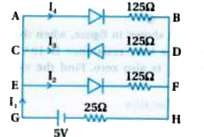Therefore are 6×1019 electrons per unit cubic metre of pure semiconductor. What will be the number of holes for this semiconductor of dimension 1cm×1cm×2cm? Solution in Gujrati
6×1019
1.2×1014
12×1014
2×106
The correct Answer is:B
1.2×1014
Volume of crystal v=l×b×h
=1×1×2×10−6m3
=2×10−6m3
In pure semiconductor ne=nh=6×1019m−3
∴ Total number of holes in crystal,
N=neV=6×1019×2×10−6=12×1013
Topper's Solved these Questions
- BOOK - KUMAR PRAKASHANCHAPTER - SEMICONDUCTOR ELECTRONICS : MATERIALS, DEVICES AND SIMPLE CIRCUITS EXERCISE - Section-D : Multiple Choice Questions (MCQs) (MCQs asked in Competitive Exams)129videos
SEMICONDUCTOR ELECTRONICS : MATERIALS, DEVICES AND SIMPLE CIRCUITS
- BOOK - KUMAR PRAKASHANCHAPTER - SEMICONDUCTOR ELECTRONICS : MATERIALS, DEVICES AND SIMPLE CIRCUITS EXERCISE - Section-C: NCERT Exemplar Solution (Long Answer Type Questions)10videos
SEMICONDUCTOR ELECTRONICS : MATERIALS, DEVICES AND SIMPLE CIRCUITS
- BOOK - KUMAR PRAKASHANCHAPTER - SAMPLE QUESTION PAPER EXERCISE - PART-B SECTION-C5videos
SAMPLE QUESTION PAPER
- BOOK - KUMAR PRAKASHANCHAPTER - WAVE OPTICSEXERCISE - SECTION-D (MULTIPLCE CHOICE QUESTIONS (MCQS)) (MCQS FROM DARPAN BASED ON TEXTBOOK)239videos
WAVE OPTICS
Similar Questions
At absolute zero temperature Si acts as ……..
03:09View Solution
If each diode in figure has a forward bias resistance of 25Ω and infinite resistance in reverse bias, what will be the values of the current I1,I2,I3andI4?02:21View SolutionTwo charges –q and +q are located at points (0, 0, –a) and (0, 0, a), respectively.
(a) What is the electrostatic potential at the points (0, 0, z) and (x, y, 0) ?
(b) Obtain the dependence of potential on the distance r of a point from the origin when r/a>>1 .
(c) How much work is done in moving a small test charge from the point (5,0,0) to (–7,0,0) along the x-axis? Does the answer change if the path of the test charge between the same points is not along the x-axis?01:18View SolutionAccording to particle theory of light what is the velocity of light in a dense medium, compared to that in rare medium ?
03:00View SolutionIn a pure semiconductor the number of conduction electrons is 6×1019per cubic metre.How many holes are there in a sample of size 1cm×1cm×1mm?
02:45View SolutionIn a pure semiconductor, the number of conduction electron is 6xx10^(19) per cubic metre of size 1 cm xx 1 cmxx2mm ?
03:20View SolutionIn pure semiconductor, the number of conduction electrons is 6 xx 10^18 per cubic metre. How many holes are there in a sample of size 1 cm x 1 cm x 1 mm?
04:19View SolutionIn an intrinsic (pure) semiconductor, the number of conduction electrons is 7xx10^(19) per cubic meter. Find the total number of current carriers (electrons & holes ) in a same semiconductor of size 1 cm x 1 cm x 1mm.
03:05View SolutionIn a pure semiconductor, the number of conduction electron is 6×1019 per cubic meter. How many holes are there in a sample of size 1 cm x 1 cm x 2mm ?
03:00View Solutionएक शुद्ध अर्द्धचालक में 6×1019 चालान इलेक्ट्रॉन प्रति मीटर3 है। अर्द्धचालक के 1cm×1cm×1mm आकार के नमूने में - (i ) चालन इलेक्ट्रॉनों की संख्या, (ii ) होलों की संख्या ज्ञात कीजिये।
02:45View Solutionकिसी शुद्ध अर्धचालक के नमूने का आकार 1cm×1cm×2cm है । यदि इसके प्रति घनमीटर में इलेक्ट्रॉनों की संख्या 6×1019 हो , तो इस नमूने में होलो (holes) की संख्या ज्ञात करे ।
03:08View Solutionएक शुद्ध अर्द्धचालक में मुक्त इलेक्ट्रॉनों की सान्द्रता 6×1019 प्रति मीटर है। आकार 1 सेमी × 1 सेमी × 2 मिमी के प्रतिदर्श में होलों की संख्या ज्ञात कीजिए।
03:01View SolutionIn an intrinsic (pure) semiconductor, the number of conduction electrons is 7×1019 per cubic meter. Find the total number of current carriers (electrons & holes ) in a same semiconductor of size 1 cm x 1 cm x 1mm.
02:39View SolutionIn a pure semiconductor, the number of conduction electron is 6×1019 per cubic meter. How many holes are there in a sample of size 1 cm x 1 cm x 2mm ?
02:44View Solutionशुद्ध अर्धचालक में, चालक इलेक्ट्रॉनों की संख्या 6×1018 प्रति घन मी है। 1cm×1cm×1mm आकार के नमूने में कितने होल होंगे?
02:57View SolutionTherefore are 6xx10^(19) electrons per unit cubic metre of pure semiconductor. What will be the number of holes for this semiconductor of dimension 1 cm xx 1 cm xx 2 cm ?
View Solution

